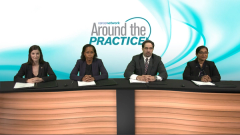
Treatment Considerations for Transplant-Ineligible Patients with MM
The expert panel gives an overview of factors that influence treatment decisions in patients with transplant-ineligible multiple myeloma.
Episodes in this series

Transcript:
Nausheen Ahmed, MD: Dr Abdallah, what are your thoughts about VRd [bortezomib-lenalidomide-dexamethasone] vs DRd [daratumumab-lenalidomide-dexamethasone] based on the first of the SWOG study and comparing that to the MAIA trial?
Al-Ola Abdallah, MD: I think, as Leyla said, we have to look at different aspects. I think the problem here is that before the overall survival [OS] benefit, we saw it. I was still saying the VRd is supposed to be the standard here. I’m a believer about 2 things; myeloma treatment has to be [about] either the quality of life or survival. If you don’t have these, you don’t have any reason to change the standard of care just because the treatment looks fancier.
Regarding the quality of life, there’s nobody in this room [who] doubts that daratumumab is better than Velcade [bortezomib]. I will tell you that based on my personal experience, there’s a bigger chance that you [will] discontinue the Velcade due to the side effects compared to daratumumab. And especially now with the daratumumab becoming a [subcutaneous] injection, it’s really more convenient. It used to be very difficult with IV [intravenous]. Remember that was the days [when] patients [wondered] how long did it have to be IV? How often you have to administer it? And how long they have to wait? Some institutions were doing it 2 days in a row for the first dose. Now it’s a [subcutaneous] injection. It’s very easy.
The side effects, really you can’t compare it to be honest with you. The chances that a patient can stay on daratumumab-Revlimid [lenalidamide]-dexamethasone on the entire outcome [is higher] vs the Velcade-Revlimid-dexamethasone. Most of the time [patients] ended up dropping Velcade. I have seen that multiple times. So in terms of quality of life, I have seen the daratumumab really exceed Velcade in these patients.
One of the problems we still face is [knowing] what the benefit of daratumumab is in high-risk myeloma. That’s where I struggle a lot. If I have a patient with standard risk, honest opinion, ineligible for transplant, of course, all of us agree, it’s not an eligible for transplant. I think daratumumab-Revlimid-dexamethasone will be a standard here. If there is a question, and he is a high risk, he’s fit, and has no neuropathy, I might do the Velcade as strategy. Why? Because I think Velcade will be better in that case. Maybe that’s why I believe it’s the backbone for any high-risk myeloma based on the SWOG study that compared VRd vs DRd. It showed there are no significant changes in the PFS [progression-free survival] normal survival. That’s my strategy.
Now in this case, as you can see, the patient is high risk. There are a lot of comorbidities—diabetes, [INAUDIBLE], coronary artery diseases. Leyla mentioned the Velcade can cause Kienböck's [disease], orthostatic hypotension, and dizziness. I have patients who have that, and I’m sure the patient is on blood pressure medication. So using the daratumumab I think is maybe a better approach to keep the quality of life. If these comorbidities were not there and he’s eligible for transplant would I use Velcade? The strategy will be to use Velcade upfront. I know he’s going to progress; I’ll use daratumumab as a second option. But in this case, I will 100% say that daratumumab will be the safest approach with his comorbidities. So I will say that standard of care for standard-risk patients, I will use daratumumab-Revlimid-dexamethasone. [For] high-risk patients, I will look at the patient and decide between VRd and daratumumab-Revlimid-dexamethasone.
Going back to you, Jordan, adding the daratumumab to Revlimid-dexamethasone, [which has] been the standard of care for frail patients. And now we have the VRd, as we’ve talked about. In frail patients, do you think it’s safer to have daratumumab-Revlimid-dexamethasone?
Jordan Snyder, PharmD: Adding daratumumab to Revlimid-dexamethasone resulted in, like the GRIFFIN trial we talked about earlier, higher rates of cytopenia and more infections because of that and likely secondary to those side effects. Those patients in the DRd arm had more decreases of their Revlimid dose and more discontinuation of Revlimid because of those side effects. I think it’s tolerable, and we’ve seen it tolerable for our patients that are otherwise not eligible for transplant. But I think there’s a couple of things to take into consideration and that we might need to back off on our Revlimid dose should they run into issues.
Al-Ola Abdallah, MD: Jordan, also one of the things we use here is carfilzomib in elderly patients. Maybe it’s not typical case but let’s say we don’t have any heart problems, no coronary disease patient, no issues with that. We didn’t have the daratumumab. Let’s say it was before the MAIA trial. You have VRd vs KRd [carfilzomib-Revlimid-dexamethasone] in a patient who is not eligible for transplant. Would you consider the option of carfilzomib with these patients?
Jordan Snyder, PharmD: I think it’s certainly an option. I think you need to take into consideration what comorbidities the patient has when deciding between RVd and KRd. In the ENDURANCE trial there were higher rates of cardiac toxicity, pulmonary toxicity, and renal toxicity when compared to RVd. So if there’s any concerns in that patient, you might want to consider using RVd. There were higher rates of neuropathy in RVd. Not surprising. We see that all the time. I think if they have diabetes [or] already have a history of neuropathy we might be more inclined to pick KRd instead.
Al-Ola Abdallah, MD: Jordan, this is something we have been seeing in our blood, plasma, and muscle disorder clinic, and also in the BMT [blood and marrow transplant]. Patients who come with renal failure and induction therapy, the first thing they start is cyclophosphamide-Velcade-dexamethasone. They opted not to do Revlimid. In my opinion, Revlimid is kind of the top notch. Once I start the patient on Revlimid, if [they weren’t] responding to cyclophosphamide, suddenly, they respond really good. Is there any major contraindications that we [have] that we can be aware of? Why are we not using Revlimid in real sufficiency? How we can approach that better?
Jordan Snyder, PharmD: Yeah, in recent years, there’s been more and more evidence to support that you can safely use Revlimid in these patients with renal dysfunction. We see it in our clinic. You just have to make sure you’re appropriately dose adjusting it. We’ve even used it successfully in a patient on hemodialysis. Now you do tend to see a little bit more anemia and rashes develop in patients that have renal dysfunction on Revlimid. But otherwise, neutropenia is pretty similar. A lot of times you actually see renal function begin to potentially improve, especially if it was secondary to the myeloma.
Al-Ola Abdallah, MD: Leyla, we got the patient on that. Now this is after finishing the induction therapy, and this patient [is] in complete response. I think the difference between this SWOG study that we already like is that eventually you’re going to move on to maintenance therapy. And there was a proven overall survival even using Revlimid. And I think that makes patients more excited. For the MAIA trial, we do the same thing. We just continue the daratumumab. Although its [only] once a month, but there’s still the injection continuing. Any thoughts about that? Do you change your approach here? Do you make any modification [INAUDIBLE] for this?
Leyla O. Shune, MD: So looking at the MAIA trial and the amazing outcome kind of PFS and OS, I tried to stay true to the MAIA trial. But realistically, you have to adapt the patients. If the patients have any cytopenias or is dealing with a steroid hypercalcemia, you could lower the steroid dose or stop altogether. But once we get to the monthly daratumumab and Revlimid, I tried to keep those at the minimum [doses] going throughout the progression.
Transcript edited for clarity.
Newsletter
Stay up to date on recent advances in the multidisciplinary approach to cancer.




















































































